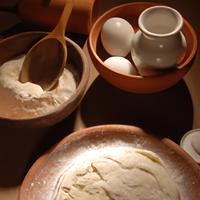
1 serving (30 grams) contains 110 calories, 3.0 grams of protein, 0.3 grams of fat, and 22.8 grams of carbohydrates.

Log this food in SnapCalorie

Nutrition Information
Calories |
457.5 | ||
|---|---|---|---|
% Daily Value* |
|||
| Total Fat | 1.2 g | 1% | |
| Saturated Fat | 0.2 g | 1% | |
| Polyunsaturated Fat | 0 g | ||
| Cholesterol | 0 mg | 0% | |
| Sodium | 875 mg | 38% | |
| Total Carbohydrates | 95 g | 34% | |
| Dietary Fiber | 3.4 g | 12% | |
| Sugars | 0.4 g | ||
| protein | 12.5 g | 25% | |
| Vitamin D | 0 mcg | 0% | |
| Calcium | 18.8 mg | 1% | |
| Iron | 5.1 mg | 28% | |
| Potassium | 133.8 mg | 2% | |
* Percent Daily Values are based on a 2,000 calorie diet. Your daily values may be higher or lower depending on your calorie needs.
Food Attributes
Source of Calories
About Self rising flour
Self-rising flour is a versatile ingredient made from refined wheat flour blended with baking powder and salt to provide leavening. This combination eliminates the need to add separate rising agents, making it ideal for quick breads, biscuits, pancakes, and certain cakes. Originating in 19th-century England, it gained popularity for its convenience in baking. While self-rising flour simplifies recipes, it lacks the fiber and nutrients found in whole-grain flours, as it’s made from refined wheat. The added baking powder contributes sodium, which may be a concern for individuals monitoring salt intake. Despite these considerations, it serves as an accessible option for creating light, airy baked goods without extensive preparation. To boost nutritional value, pair recipes using self-rising flour with wholesome ingredients like fruits, nuts, or whole grains.



